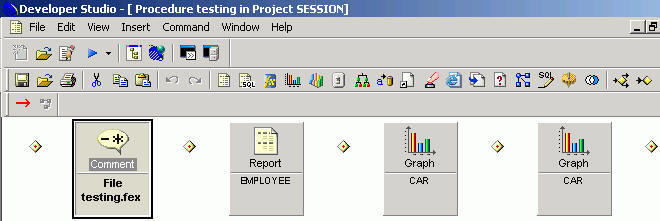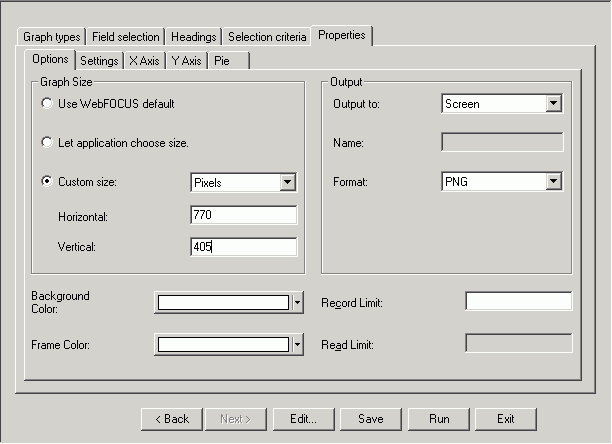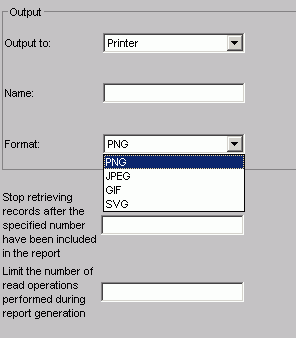Running, Saving, and Printing Your Graph
In this section: How to: Reference: |
When you run your graph, you may print the output directly from
the browser.
Note: If your graph labels or legends are not appearing
correctly when you run your graph, see How to Change Color Settings for
details on correcting this.
In the Managed
Reporting environment, ifyou log
off Managed Reporting without first closing the Graph Assistant, you must
manually close the tool.
x
Procedure: How to Save Your Graph From the Graph Assistant in the Managed Reporting Environment
-
Click Save or Save
As from the Graph Assistant.
-
From
the Save New Standard Report dialog box, enter a name for the
graph.
Note: If
you are editing an existing graph, clicking Save will automatically
save the edits to the current graph file. You will not be prompted
to name the file again.
x
Procedure: How to Save Your Graph to a File in the Developer Studio Environment
-
Open
the procedure that contains the graph and add the following before
the Graph:
A FILEDEF command that defines the directory to which your
graph file is saved. You may create a FILEDEF command with the Allocation
Wizard. This step is optional. You do not need a report component
to HOLD a graph. If you do not include a FILEDEF command, the graph
will be saved to a temporary location on the WebFOCUS Reporting
Server.
Your procedure viewer should now look like the following
image.

-
Click
the Option subtab of the Properties tab in the
Graph Assistant.
-
From
the Output to drop-down list, choose Screen,
File, or Printer.
-
Name
your file in the text box provided.
-
Select
either PNG, JPEG, GIF,
or SVG from the format drop-down list. The
default is PNG.
-
Click Run.
You may open your output file by selecting Open from
the File menu in your browser.
Note: When
saving a graph, if the graph contains a second horizontal category
(that is a horizontal field that produces multiple graphs), the
value in the FOCUS HEADING should not be saved as part of the image
file. Instead, the horizontal field name is embedded in the page
heading of the graph to identify the graph.
x
Procedure: How to Save Your Graph to a File in the Managed Reporting Environment
Note: You
must use the Allocation Wizard to create a FILEDEF command before
you save a graph to a file. This is where the file will be saved
to.
For details, see the Creating Reporting Applications With Developer Studio manual.
-
Click
the Properties tab of the Graph Assistant.
-
Click
the Options subtab.
-
Select File from
the Output to list box.
-
Type
the filename in the Name text box.
-
Select
either PNG, JPEG, GIF, PDF/SVG,
or PDF/GIF from the format list box. The
default is PNG.
-
Click Run.
The output file is saved in the directory specified in the FILEDEF
command if the IBIJAVAPATH has been set as a system environmental
variable. Otherwise, the output appears in the browser in the specified
format. From the browser, you can save the graph on your local system.
Note: You
may open your output file by selecting Open from
the File menu in your browser.
When saving a graph as a GIF
file, if the graph contains a second horizontal category (that is
a horizontal field that produces multiple graphs), the value in
the HEADING will not be saved as part of the GIF file. Instead,
to identify the graph, the horizontal field name will be embedded
in the page heading of the graph.
x
Reference: Saving Options
When
you click the Save or Save As button, you save your report (procedure).
If you make changes in your report without subsequently saving them
and then click Quit, you are prompted with the following options:
-
Yes. Click
to save your changes and exit the report.
-
No. Click
to discard your changes and exit the report.
-
Cancel. Click
to return to your report to continue working or use Save or Save
As to save your changes and then click Quit to exit your report.
Note: If
you are a Managed Reporting Administrator
or developer with DataServers access, when you create a new
graph from Dashboard, you can change your Server and/or Application
Path settings from the New Report window. If you change at least
one of these settings, the Save and Save As dialog boxes will let
you change both values when saving. If you did not change at least
one of them on the initial window, you will not be able to change
either value when saving.
x
Procedure: How to Run Your Graph
After
creating your graph in the Graph Assistant, click Run from
any tab in the Graph Assistant to view your graph output.
When running graphs in GIF format on a
UNIX platform with the HEADLESS configuration, the graph may not
appear properly. You may see a red X instead of your image. This
is due to methodology Sun uses when creating images without a head,
which does not currently support GIF images.
Note: Running applet graphs in
the Graph Assistant with the setting GRAPHENGINE=OLD works with
both the Sun and Microsoft VM. Applet graphs with the setting GRAPHENGINE=NEW
work only with the Sun VM. If you have a graph with the setting GRAPHENGINE=NEW
and you are using Microsoft VM, you should either update your Java Plug-in
or change your GRAPHENGINE setting.
GRAPHENGINE=NEW and GRAPHEDIT=ON are mutually
exclusive. If you specify GRAPHEDIT=ON and GRAPHENGINE=NEW, you
get an error message stating that GRAPHEDIT=ON is not supported
with GRAPHENGINE=NEW.
x
Reference: Options Available on All Tabs in the Managed Reporting Environment
The
following options are available from any tab of the Graph Assistantin the Managed Reporting environment:
-
Save/Save As
- Click Save to save your graph. Click Save As to open the
Save New Standard Report dialog box.
-
Run/Run Deferred
- Click Run to run your graph. Click
Run Deferred to run your graph at a later time.
-
Help
- Click the icon to access help about the area of the tab in
which you are working. Click About to open a window describing the
version of Graph Assistant in which you are working.
-
Quit
- Click Quit to quit the application.
x
Procedure: How to Print Your Graph
-
Run
your graph.
-
From
the browser, select Print from the File menu.
x
Procedure: How to Send Graph Output Directly to a Printer
-
From
the Properties tab, click the Options subtab.
-
Select Printer from
the Output list box.
You do not need to provide a name or select a format.
-
Click Run.
The graph prints to your default printer setting.
x
Procedure: How to Change Color Settings
-
From
the Windows Control Panel, select Display.
-
Click
the Settings tab.
-
In the
Color palette box, click the drop-down arrow and select True Color (32
bit) or a higher color count.
-
Click OK.
If you
use different color settings from this recommended value, your graphs may
appear in grayscale format.
x
The following are descriptions
of the graph display formats.
x
Reference: Choosing Formats for Output to the Screen, a File, or Printer
When
you create or edit a graph in Graph Assistant, you can choose among
these formats in the Output section in the Options tab. If you are
designating Output To the Screen, all options listed in Graph Display Formats are available,
as shown in the Format drop-down list.
The following image shows the Options
subtab in the Developer Studio environment.

The following image shows the Options subtab in the Managed Reporting environment.

If you are designating Output to File,
the PNG, JPEG, GIF, and SVG options are available.
The following image shows the Output section
of the Options subtab, in the Managed Reporting environment, with
the Output to File option selected.

If
you are designating Output to a Printer, the PNG, GIF, and SVG options
also are available.
The
following image shows the Output section of the Options tab, in the Managed Reporting environment, with
the Output to Printer option selected.





